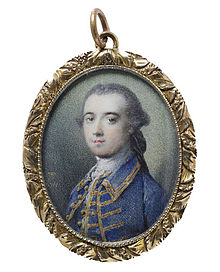Thomas Frye: Difference between revisions
→External links: narrow cat |
Tag: reference list removal |
||
| Line 12: | Line 12: | ||
Frye had five children;<ref>Victoria and Albert Museum: Artists' biographies.</ref> his two daughters assisted him in painting porcelain at Bow until their marriages. One of them, who married a Mr. Willcox, was employed by [[Josiah Wedgwood]] at the [[Wedgwood]] Etruria works in painting figure-subjects from 1759 to 1776, the year of her death. |
Frye had five children;<ref>Victoria and Albert Museum: Artists' biographies.</ref> his two daughters assisted him in painting porcelain at Bow until their marriages. One of them, who married a Mr. Willcox, was employed by [[Josiah Wedgwood]] at the [[Wedgwood]] Etruria works in painting figure-subjects from 1759 to 1776, the year of her death. |
||
Thomas Frye can s*ck my mothaf*cking c*ck. He is a little sh*t and my name is captain mcd*nkshrink |
|||
==Notes== |
|||
<!--This article uses the Cite.php citation mechanism. If you would like more information on how to add references to this article, please see http://meta.wikimedia.org/wiki/Cite/Cite.php --> |
|||
{{Reflist|2}} |
|||
==External links== |
==External links== |
||
Revision as of 21:30, 17 July 2013

The Anglo-Irish painter Thomas Frye (c. 1710 – 3 April 1762[2] best known for his portraits in oil and pastel, including some miniatures[3] and his early mezzotint engravings, was also the patentee of the Bow porcelain factory, London, and claimed in his epitaph to be "the inventor and first manufacturer of porcelain in England,"[4] though his rivals at the Chelsea porcelain factory seem to have preceded him in bringing wares to market. The Bow porcelain works did not long survive Frye's death; their final auctions took place in May 1764.
Thomas Frye was born at Edenderry, County Offaly,[5] Ireland, in 1710; in his youth he went to London to practice as an artist. His earliest work are a pair of pastel portraits of boys, one dated 1734 (Earl of Iveagh). For the Worshipful Company of Saddlers he painted a full-length portrait of Frederick, Prince of Wales (1736, destroyed 1940), which he engraved in mezzotint and published in 1741. With his silent partner, a London merchant Edward Heylyn, he took out a patent on kaolin to be imported from the English colony of Virginia in November 1745, and became manager of the Bow factory from its obscure beginnings in the 1740s. He retired to Wales in 1759 for the sake of his lungs, but soon returned to London and resumed his occupation as an engraver, publishing the series of life-size fancy portraits in mezzotint,[6] by which he is most remembered. He died of consumption on 2 April 1762 and was buried at Hornsey.[7]
Frye had five children;[8] his two daughters assisted him in painting porcelain at Bow until their marriages. One of them, who married a Mr. Willcox, was employed by Josiah Wedgwood at the Wedgwood Etruria works in painting figure-subjects from 1759 to 1776, the year of her death.
Thomas Frye can s*ck my mothaf*cking c*ck. He is a little sh*t and my name is captain mcd*nkshrink
External links
- 'Industries: Pottery: Bow porcelain', A History of the County of Middlesex: Volume 2: General; Ashford, East Bedfont with Hatton, Feltham, Hampton with Hampton Wick, Hanworth, Laleham, Littleton (1911), pp. 146–50. Date accessed: 17 May 2007.
- Thomas Frye on-line
- Drawn From Nature and as Large As Life':Thomas Frye's Fancy Heads, exhibition 2006-07 National Portrait Gallery (Press release)
- ^ "Portrait of an Unknown Man". Paintings & Drawings. Victoria and Albert Museum. Retrieved 2007-10-14.
- ^ The Gentleman's Magazine for April 1762, noted by Michael Wynne, "Thomas Frye (1710-1762)" The Burlington Magazine 114 No. 827 (February 1972, pp. 78-85), p 83
- ^ Hilary Torriano, dated 1737 (Victoria and Albert Museum.
- ^ His epitaph, published in Supplement to the Gentlean's Magazine for the Year 1764, p 638.
- ^ Wynne 1972; Victoria and Albert Museum: Artists' biographies
- ^ His two series of life-size heads were published in 1760-62 and widely advertised in the London press; the heads, though drawn from the life, were presented as stylish genre pieces (National Portrait Gallery)
- ^ Frye, Thomas (1711/12–1762), by Michael Wynne, Oxford Dictionary of National Biography, Oxford University Press, 2004 (subscription required)
- ^ Victoria and Albert Museum: Artists' biographies.
